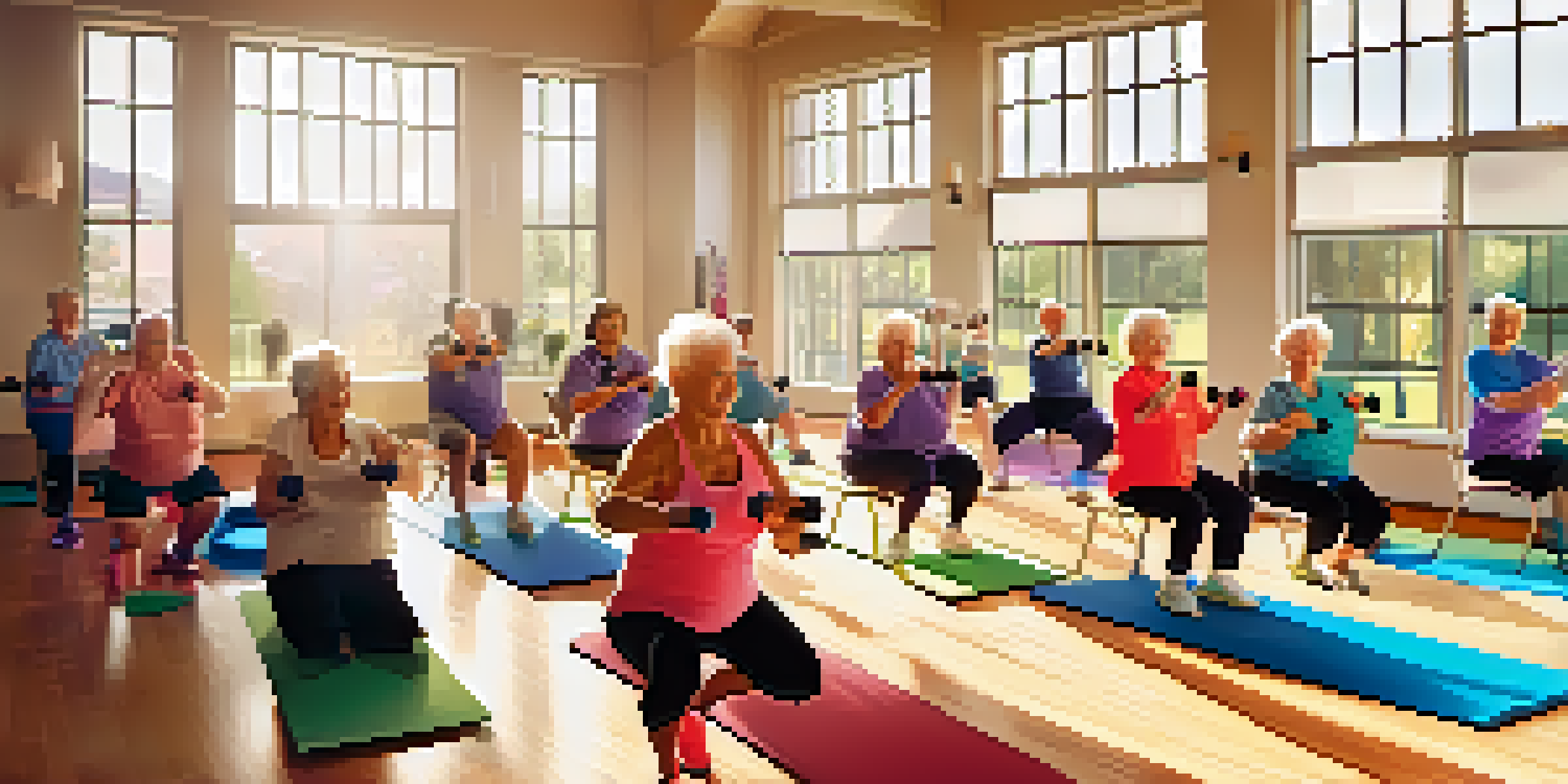Understanding the Benefits of Circuit Training for Seniors

What is Circuit Training and Why It Matters for Seniors
Circuit training is a workout method that combines different exercises performed in sequence, with minimal rest in between. For seniors, this approach is particularly beneficial as it allows for a variety of movements that can engage different muscle groups. This not only makes workouts more interesting but also helps in improving overall strength and flexibility.
Physical fitness is not only one of the most important keys to a healthy body, it is the basis of dynamic and creative intellectual activity.
One of the key advantages of circuit training for seniors is its adaptability. Each exercise can be modified to fit the individual's fitness level, making it accessible for those who may have mobility issues or are just starting their fitness journey. By offering a personalized workout experience, seniors are more likely to stick with it and see results.
Additionally, circuit training can be a great social activity. Many seniors enjoy group classes where they can connect with others who share similar fitness goals. This social interaction can boost motivation and create a sense of community, which is incredibly valuable for overall well-being.
Improving Cardiovascular Health Through Circuit Training
One of the standout benefits of circuit training is its ability to enhance cardiovascular health. By incorporating exercises that raise the heart rate, seniors can improve their endurance and heart function over time. This is especially important as heart health tends to decline with age, making regular aerobic activity essential.

Moreover, circuit training allows for both aerobic and strength training elements, which can provide a comprehensive workout. For example, alternating between resistance exercises and cardio bursts can effectively promote heart health while building muscle. This dual approach helps seniors maintain their independence and functionality in daily activities.
Circuit Training Boosts Senior Fitness
Circuit training offers a versatile and adaptable workout that enhances strength, balance, and cardiovascular health for seniors.
It's also worth noting that engaging in regular cardiovascular exercise can lead to better mood and energy levels. Many seniors report feeling more vibrant and mentally sharp after incorporating circuit training into their routine, highlighting the profound impact of physical activity on mental health.
Enhancing Strength and Balance for Daily Activities
Strength training is crucial for seniors as it helps combat the natural decline in muscle mass that occurs with age. Circuit training is an efficient way to incorporate strength-building exercises, such as squats or resistance bands, into a workout. Improved strength directly translates to better performance in daily activities like lifting groceries or climbing stairs.
The secret of change is to focus all of your energy, not on fighting the old, but on building the new.
Balance is another critical component of fitness that circuit training addresses. Many circuit workouts include exercises that challenge stability, such as single-leg stands or modified yoga poses. By enhancing balance, seniors can reduce their risk of falls, which are a leading cause of injury in older adults.
Ultimately, the combination of strength and balance training within circuit workouts fosters greater independence. Seniors who feel stronger and more stable are more likely to engage in social activities, travel, and enjoy life to the fullest, proving that fitness is about more than just physical health.
Flexibility and Mobility: Key Benefits of Circuit Training
Flexibility is often overlooked but is essential for maintaining a good range of motion in joints. Many circuit training routines include stretches and mobility exercises that help improve flexibility. This is particularly beneficial for seniors, as it can alleviate stiffness and discomfort often experienced with aging.
Incorporating flexibility training into a circuit routine can enhance performance in other exercises. For instance, better flexibility can lead to improved form during strength training, which not only maximizes effectiveness but also reduces the risk of injury. It's a win-win scenario that promotes a safer workout environment.
Social Benefits of Group Workouts
Participating in group circuit training fosters social connections, helping combat feelings of loneliness while promoting overall mental well-being.
Additionally, greater mobility can lead to improved overall quality of life. Seniors who can move freely are more likely to engage in activities they enjoy, whether it's gardening, playing with grandchildren, or simply walking around the neighborhood. Circuit training, with its focus on flexibility, can empower seniors to stay active and engaged.
Mental Health Benefits of Regular Circuit Training
Physical activity, including circuit training, has been linked to improved mental health outcomes for seniors. Engaging in regular exercise can reduce symptoms of anxiety and depression, promoting a more positive outlook on life. This is particularly important for seniors, who may face loneliness or isolation.
Moreover, the social aspect of group circuit training can enhance mental well-being. Sharing experiences with peers during workouts fosters connections and friendships, reducing feelings of isolation. It's amazing how a simple workout can create a sense of belonging and community.
Lastly, the cognitive benefits of exercise shouldn't be ignored. Studies show that physical activity can improve memory and cognitive function, which is crucial for maintaining independence as we age. Circuit training, with its combination of movement and social interaction, serves as a valuable tool for mental acuity.
Customizing Circuit Training for Individual Needs
One of the most appealing aspects of circuit training is its flexibility in customization. Seniors can tailor workouts to their specific needs and preferences, ensuring that they are both effective and enjoyable. This personalization makes it easier for individuals to stay motivated and engaged in their fitness journey.
For instance, a senior with arthritis might focus on low-impact exercises that are easy on the joints, while another might prioritize strength training to build muscle mass. By adjusting the intensity, duration, and types of exercises, circuit training can accommodate a wide range of fitness levels and health conditions.
Customizable Workouts for Everyone
Circuit training can be tailored to meet individual fitness levels and needs, making it accessible and enjoyable for seniors.
Additionally, working with a trainer or joining a class can provide valuable guidance. Instructors can help seniors select appropriate exercises and monitor their form, ensuring safety and effectiveness. This tailored approach not only boosts confidence but also maximizes the benefits of circuit training.
Getting Started with Circuit Training: Tips for Seniors
Starting a new workout routine can be daunting, but with circuit training, seniors can ease into it at their own pace. It's essential to begin with simple exercises that build confidence and gradually progress to more challenging movements. Listening to one's body is key, and rest days are just as important as workout days.
Joining a local fitness class designed for seniors can also be a great way to get started. These classes often provide a supportive environment where individuals can learn circuit training techniques while meeting new friends. The camaraderie can make workouts feel less like a chore and more like an enjoyable experience.

Lastly, incorporating circuit training into a routine doesn't have to be time-consuming. Even short, 20-30 minute sessions can be effective if done consistently. The goal is to find a rhythm that works for each individual, making fitness an accessible and enjoyable part of daily life.